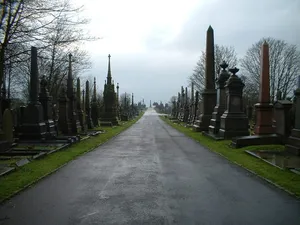Undercliffe Cemetery
Built in grounds of mansion sold in 1851 for £3,400. Bradford Cemetery Co. managed the site and in 1854 the first burials took place. Is still used as a cemetery today. Is a 25 acre site containing 23,000 graves. Victorians believed that in death, as in life, every man had his place. The cemetery contains two sections. The eastern section is unconsecrated for nonconformists. The western section is for Anglicans. The site is dramatic with a central promenade overlooking Bradford. The architect was William Gay of Leicester who was the first manager. Contains every variety of Victorian funerary art.
Notable graves
The Quaker Burial Ground
The Burial Act Amendment of 1855 closed many graveyards of nonconformist chapels and Anglican churches. The Society of Friends purchased plots for 97 graves in 1855. Note the plain, flat memorial stones.
Harold Wilfred Scott
Drowned in British Columbia
Rev. Walter Scott
President and Theologian tutor of the Airedale College Chapel of Bradford
Walter Calver
Proprietor of a puppet theatre which visited much of northern England and performed in front of Queen Victoria.
William Cudworth
A notable Victorian, local historian.
Miles Moulson
Moulson was a monumental mason. The demand for such services is illustrated by the architecture of the cemetery. Memorial takes form of a life-size female figure.
Joseph Farrar
Grey granite obelisk. Farrar was a hatter, a founder of the Bradford Mechanics Institute and Mayor from 1863-4
Henry Brown
Memorial of rough, grey granite. One of first directors of cemetery, proprietor of Brown, Muffs department store in Market Street, Mayor from 1856-9.
Robert Milligan
Impressive 20 foot high pillar surmounted by a Celtic cross. Note highly flattering inscription. First Mayor of Bradford on 1847 and MP. Erected palazzo style worsted warehouse. Funeral cortege was headed by representatives of Bradford Corporation, Board of Guardians and JPs. Then friends, policemen and the undertaker. Then employees. Then the hearse drawn by six black plumed horses. Then four coaches containing the male members of the family. Then gentlemen in private carriages.
Samuel Smith
Mayor of Bradford 1851-4. Leading social reformer
The Behrens Family
Memorial is huge Baroque tablet. Leading member of German community connected with Little Germany.
Holden Family
A Graeco-Roman temple decorated with oak leaves and angels from stone imported from Belgium.
William Sharp
Fishmonger. Massive stone obelisk. Note inscription from Thomas Paine’s The Rights of Man
Swithen Anderton
Elaborate Gothic edifice in the historic core of the cemetery, a sought after burial place. Heavily decorated stone sarcophagus surmounted by Gothic arches, topped by a steeple. Is a scaled down version of the Scott monument in Edinburgh’s Princes Street. Anderton was wool baron.
Illingworth Mausoleum
Is of grey granite in the form of an Egyptian temple. Its entrance was originally sealed with bronze doors. Note the sphinxes. Decorated with the insignia of the Sun God. Illingworth was a leader of Bradford Liberalism.
Sir Isaac Holden
A stepped pedestal decorated with bowl and torch (the light of life). Liberal MP and partner of Lister.
Daniel Illingworth
Head of the Illingworth dynasty. Set up spinning mill in Tetley Street. Memorial is a tall marble column surmounted by a draped urn.
The Essex Regiment
Move to the consecrated part. Stone headstone of crossed sabres, crossed flags and the badge of the regiment. Erected by non-commissioned officers and men to the memory of 5 soldiers.
William Gay
Architect of cemetery and first registrar.
Barlow Memorial
Shows reclining lady holding small baby in her arms. Erected to memory of Anne Barlow and her daughter Sarah Elizabeth who survived for only a few weeks. Illustration of perils of childbirth.
William Mawson
Egyptian obelisk with bronze portrait of William Mawson, important architect.
Thomas Speight
Wool comber and inventor. Mayor of Bradford 1896-7, the year Bradford became a city.
Sir Henry Mitchell
Mayor 1874-5. City’s first freeman and founder of Bradford Technical College
Rev Jonathan Glyde
Glyde was minister of Horton Lane Chapel
William Evans Glyde
Brother of above. A stone cross.
William Byles
Prominent non-conformist. Editor Bradford Observer. Campaigner for incorporation.
James Law
Rough grey granite memorial. Mayor 1867-8. Prominent member of Horton Lane Independent Chapel
The Godwin family
Polished grey granite tombstone. Family were prominent nonconformists and local dignitaries. John set up Bradford public library.
The Smith Monument
30 foot high monument, stands at the end of the terrace walk and overlooks Bradford. Joseph Smith was the land-agent who sold the burial plots. He had written into his contract the fact that he could occupy the cemeteries principal location.
Charles Rice
Manager of Bradford’s Theatre Royal

